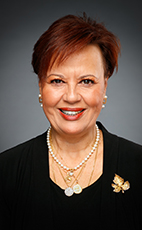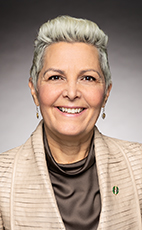44th Parl. 1st Sess.
February 8, 2024 10:00AM
- Feb/8/24 5:33:29 p.m.
- Watch
Madam Speaker, I would like to thank my hon. colleague, the member for Saanich—Gulf Islands, for her recognition of the importance of this legislation and her support of it during multiple interventions here in the chamber of the House of Commons.
We look forward to seeing this being created so that we can move on with it. I would love to see some of our west coast indigenous artists and other west coast artists eventually be selected as a part of this process.
85 words
- Hear!
- Rabble!
- add
- star_border
- share
- Feb/8/24 5:34:09 p.m.
- Watch
Madam Speaker, as my colleague mentioned, Bill S‑202 has to do with the appointment of the parliamentary visual artist.
As I said earlier, I am a stage and film actor, as well as a fan of literature. I therefore agree that art should have a bigger place in our lives, even in Parliament. I could not agree with that more.
Today, I decided to treat myself because someone has expressed much better than I could the importance of literature and art in our lives. I am talking about David Goudreault, a slam performer and poet from Quebec. He has written a lot and has even won some awards. He was awarded the World Cup of Slam Poetry in Paris in 2011. Since then, he has been writing novels and continues to slam and do shows. We also see him on television, where he works as a commentator. His words are striking, touching, penetrating and impactful. He has a much better way with words than I do, and he wrote about how we should leave more room for art, poetry and literature in our lives.
That is why, today, I decided to treat myself and read one of David Goudreault's poems. I hope he will forgive me—
211 words
- Hear!
- Rabble!
- add
- star_border
- share
- Feb/8/24 5:35:44 p.m.
- Watch
May I ask hon. members to take conversations outside of the chamber, please, so that we can hear the speech?
The hon. member for Longueuil—Saint-Hubert.
28 words
- Hear!
- Rabble!
- add
- star_border
- share
- Feb/8/24 5:35:53 p.m.
- Watch
Madam Speaker, I am going to talk about something very serious, that is, poetry. I would like my colleagues to listen. It is not that often that we talk about poetry in the House. I am not sure we ever have. It is important that members listen.
I apologize in advance, because David Goudreault is also an extraordinary performer. When he reads his own poetry, when he speaks his own words, it is utterly amazing and fascinating. I encourage my colleagues to go see one of his shows. Still, I will read this piece, because it is worth it.I call for poetryA deep breath held in, underworld apneaFor all the teachers that won't skip a chapterHands sunk and guts poured into the subject matterA light that can express itself freelyIn free verse, spoken work, sonnets or haikus“O Captain! My Captain!”Loot the coffers and bring us poemsEnough to fill every schoolStarting in first grade: Jean Narrache for today's dictationFootball players forced to read Marie UguayHeads of the class can tackle VanierBetween math class and phys-edLet's give them credits for each moment of quietWhere speech can grow, all crooked and aliveI call for poetryIn back alleys and on farm roadsLet's have every streetworker pacing the voidWhisper Roland Giguère in misery's earLet's have poets in residenceIn every residence for senior citizensLet's pair every illiterate with a poetAnd pay them to reconquer the wordsThey can paint huge signs in front of psych wards, “Amazing specials inside!”In front of l'Assemblée nationale, “Don't feed the wild ideals”On library stone walls, “Welcome to the Art Therapy Community Centre”I call for poetryLet's have every SAQ cashier recite “La romance du vin”With every purchase of over 20 bucksLet's replace the Hockey Night theme with a poem by PozierLet's ask Anonymous to do their thingSo only works by Josée Yvon can be bought on AmazonLet's canonize Yves BoisvertLet's give Hélène Dorion a Nobel PrizeLet's have lines by Francoeur on rolling paperBeausoleil on boarding passesDesbiens on Trans Canada bus tickets Daoust on tinted glasses that cover the eyesAnd the yous and the theysI call for poetryFrom Miron's country, yet to be chosen and inventedTo the occupied lands of the last First NationsThere's more than Ani Couni, you knowWhy not teach Joséphine BaconJean Sioui and Rita MestokoshoLet their voices be heard, YawindaFrom Mohawk lands to Ivujivik, NakurmikI call for poetryIn Chloé Sainte‑Marie's mouth-shaped heartGo ahead and give her a doctorate honoris causaSo she can pawn it for a tiny fraction of her selflessness' worthAnd by the way, Montreal City, where the fuck is your Leonard Cohen Street?
478 words
- Hear!
- Rabble!
- add
- star_border
- share
- Feb/8/24 5:40:36 p.m.
- Watch
I have to interrupt the hon. member. I am sure he understands that this poem contains a word that can be offensive. Other members are already reacting.
Anything that can disrupt the House's work is inappropriate. I would ask the hon. member to put that word between brackets.
The hon. member for Longueuil—Saint-Hubert.
57 words
- Hear!
- Rabble!
- add
- star_border
- share
- Feb/8/24 5:41:13 p.m.
- Watch
Duly noted, Madam Speaker.
What about your Hélène Monette Boulevard?My GPS is no use; recognition for poets, it would seemIs harder to find than organic and fair trade cocaineI call for poetryFrom Speak White to Speak WhatFrom Michèle Lalonde to Marco MiconeBy those who blaze the trailsAnd those who draw tears from the pageBy Rodney Saint-Éloi and all our diasporasBy Herménégilde Chiasson, Georgette LeblancAnd all of Acadia straight in the eyeLet the path of poetry stretch outFrom St-Venant-de-Paquette to WendakeLet an artist from Trois-Rivières climb Duplessis's statueTo sculpt Godin's face up thereI call for poetryIn songs, on pages, in rap barsBy Gilbert Langevin, Nicole Brossard, Sol or Manu MilitariIn its noblest forms or proudly bastardizedBy our inspired successorsApathy will never recoverBy its peaks and rootsIts iridescent brothers and incandescent sistersIts promises that we will hold highWith arms open wideI call for poetryI call for poetryHoping that you will answer
I have a minute and a half left, but I do not know what I could possibly add to David Goudreault's words, what he just said, what I just read. What a magnificent poem.
Not many members in the House are artists, which is too bad. We have a lot of doctors and a lot of lawyers. We have engineers. That is fine, but it seems to me that art would help us in our debates. It would help our debates if there were more room for art, music and visual arts. There is also cinema, of course.
I could also talk about the precariousness of artists' situations. That is another debate. It is important, but we do not talk about it very much. In Quebec, 80% of artists earn less than $20,000 a year. That is the poverty line. These are the people we see on our phones, watch on television and hear on the radio. They live in precarious situations, and yet they are the spice of life in this country. They are what makes life worth living. In fact, for people who spend most of their lives on their devices, we see images, we see photos and we see videos. There are people who create them. There are people who come up with all that. There are ordinary people, and then there are artists. These people need to be paid properly, like everyone else. They have to be able to earn a living, because we need them. We need them more than ever in these difficult times.
432 words
- Hear!
- Rabble!
- add
- star_border
- share
- Feb/8/24 5:44:47 p.m.
- Watch
Mr. Speaker, today I am reminded why I love Quebec culture. I thank the hon. member.
It is an honour to stand today on behalf of the residents of Port Moody—Coquitlam to talk about the arts. Port Moody is, by design, the city of the arts due to its vibrant arts and culture scene. Not only does it have a strong community of artists, including painters, sculptors and potters, but many of these individuals also have public art installations across Canada. I will speak of one today: Sara Graham, who shared her vision with the world by installing On the Other Side of Tomorrow at the entrance of the Gordie Howe International Bridge in Windsor. Congratulations to Sara.
Port Moody is home to various arts institutions, such as galleries, theatres and studios, which provide spaces for artists to showcase their work and for the public to engage with the arts. It boasts numerous public art installations throughout the city, including sculptures, murals and interactive pieces. These artworks contribute to the cultural identity of the city and enhance public spaces. Overall, Port Moody's commitment to fostering creativity, supporting local artists and celebrating cultural diversity has earned it the moniker “City of the Arts”.
The Port Moody Arts Centre, which recently celebrated its 25th year, is a hub for artistic activities in the community. It offers a wide range of art classes, workshops, exhibitions and events for people of all ages and skill levels. The centre also houses galleries where local artists can display their work.
In Coquitlam, Place des Arts is a non-profit arts education centre offering classes and programs in visual arts, music, dance and theatre for people of all ages in the historic part of Maillardville, the largest French quartier in British Columbia. It also hosts exhibitions, concerts and performances by both local and visiting artists.
These organizations play vital roles in fostering creativity, supporting artists and enriching the cultural life of the Port Moody and Coquitlam communities. It is exciting to think that with the passing of this bill, and I thank the member for Cloverdale—Langley City, and the introduction of a new visual arts laureate position in Canada, artists from communities across this country would get more visibility.
Having visual arts laureates is important as a form of recognition for an artist's excellence and contributions to the field. It acknowledges their talent, creativity and impact on the cultural landscape and communities. Visual arts laureates often serve as ambassadors for the arts, promoting artistic expression, creativity, cultural enrichment and more. Their public visibility can help raise awareness of the importance of the arts and encourage support for artistic endeavours. This is needed now more than ever, as postpandemic times and the unrest in the world are leaving people feeling more isolated and lonely.
Visual arts laureates not only inspire emerging artists but also can excite community. Their success stories can motivate others to pursue careers in the arts and can engage a community to learn more about its own and other cultures.
One of the outlined requirements of the new visual arts laureate role is to have it represent the cultural identity and diversity in Canada. The laureate role has an opportunity to reflect different perspectives, traditions and experiences through the arts. The appointment can help ensure that a variety of voices and artistic practices are celebrated and supported, most often without words or language, making it truly inclusive.
Visual arts laureates have the potential to bring community together by engaging communities through public events, workshops and educational programs, fostering connections between artists and their audiences. Their involvement plays an important role in celebrating, promoting and having vitality in community.
Canada is home to a diverse range of artists, and I wanted to take this opportunity to highlight some indigenous visual artists, each with their own unique style and techniques. These artists create powerful and thought-provoking artworks that contribute to the rich tapestry of Canadian history. I will point out that my NDP colleague from Nunavut said that indigenous artists should be part of the diverse rotation of the new laureate.
I speak of Rebecca Belmore, who is an Anishinabe artist from Ontario, whose work addresses issues of indigenous identity, politics and social justice. She also received the Governor General's Award in Visual and Media Arts in 2013. Also, Christi Belcourt is a Métis visual artist based in Ontario, whose intricate and vibrant paintings celebrate indigenous culture, environmentalism and community. There are so many incredible visual artists in Canada and I look forward to this bill creating an additional platform for Canadians to see and learn from.
The richness of visual arts is a gift to society, and we must nurture it. At the same time, we must protect it. The creativity and ideas of artists must be protected. I think specifically about how artificial intelligence tools have brought numerous benefits to artists around the world and yet, at the same time, have put their craft and the ownership of their own ideas and work at risk.
AI tools can create art using people's thoughts and ideas, and this can lead to infringements on copyrights of artistic styles and works. The availability of Al-powered tools, like image editing or video production, may lead to a devaluation of traditional artistic skills and craftsmanship. As Al automates certain aspects of the creative process or replicates them entirely, we risk losing artists' autonomy and society loses some of those skills and techniques that have been passed down by generations.
This also raises ethical concerns about the use of Al in arts. Authorship, cultural appropriation and fair compensation are potentially at risk. For example, if an artist uses Al to generate artwork based on images or data created by others, questions may arise regarding the ownership of the resulting work and the ethical implications of using it. Another concern with Al entering in to the visual arts space is algorithms that can implant inherent biases. Discriminatory outcomes in Al could affect creative projects.
On the topic of fair compensation, artists already struggle to make a living from their art. The automation of certain artistic tasks through Al tools may lead to further job displacement for artists working in industries where Al technologies are adopted on a large scale. For example, Al-generated visual arts could potentially replace human-created content in commercial applications, reducing opportunities for professional artists to earn an income.
In closing, New Democrats want to be sure that the Speakers of both chambers exercise a fair and equitable process to select a parliamentary visual artist laureate because these are the important issues that they will be dealing with, as well as educating and sharing their beautiful art with the world. With so much talent in our country, we know this is going to be a very busy job, and the NDP supports it.
1159 words
- Hear!
- Rabble!
- add
- star_border
- share
- Feb/8/24 5:53:01 p.m.
- Watch
Resuming debate.
I now recognize the member for Cloverdale—Langley City for his five-minute right of reply.
19 words
- Hear!
- Rabble!
- add
- star_border
- share
- Feb/8/24 5:53:21 p.m.
- Watch
Mr. Speaker, I would like to thank my colleagues who spoke in favour of Bill S-202 today.
As we discuss what is hopefully the final version of Bill S-202, I am filled with a profound sense of pride in our nation's rich cultural heritage. Canadians have much to offer and, in honour of this, we ought to continue forward with the establishment of a parliamentary visual arts laureate.
Again, I would like to thank those who worked on and pushed for this legislation over many years. I thank Senator Patricia Bovey for her tremendous efforts in ensuring a genuine appreciation of the arts makes it to the House once more. I would like to thank Senator Wilfred Moore and Senator Andrew Cardozo, who have shown perseverance and commitment to this bill. Lastly, I would like to extend a heartfelt thanks to all who contributed to getting Bill S-202 to this stage.
The creation of the parliamentary visual arts laureate to go alongside the parliamentary poet laureate strengthens our recognition of the arts, while fostering a sense of pride for our country that Canadians express in the creation of their artwork. Even the very building we are in today is visited by people across Canada and from around the world for its beauty, artistic appeal and the history captured within its walls. There is no place better suited to support the continuing legacy of Canadian art through a resident artist than here.
Canada's stories, and our cultural and linguistic diversity are demonstrated in their most raw form when we, as parliamentarians, intentionally recognize our fellow citizens' abilities to strengthen our Canadian culture. When I worked as the Township of Langley's cultural services manager from 2019 to 2021, my discussions with artists heightened my understanding of how crucial art is to our resilience. Our communities flourish when we respect and encourage the creation of art within them. Art celebrates with us, mourns with us, encourages us and inspires us. Art captures moments of our history for reflection and lifts our spirits when we need to take the next step forward.
By supporting artists through the creation of a parliamentary visual artist laureate, we are taking the next step forward to ensure that Canada remains a beacon of artistic excellence for generations to come.
387 words
- Hear!
- Rabble!
- add
- star_border
- share
- Feb/8/24 5:55:21 p.m.
- Watch
The question is on the motion.
If a member participating in person wishes that the motion be carried or carried on division, or if a member of a recognized party participating in person wishes to request a recorded division, I would invite them to rise and indicate it to the Chair.
51 words
- Hear!
- Rabble!
- add
- star_border
- share
- Feb/8/24 5:55:59 p.m.
- Watch
Mr. Speaker, we request a recorded division.
7 words
- Hear!
- Rabble!
- add
- star_border
- share
- Feb/8/24 5:56:03 p.m.
- Watch
Pursuant to Standing Order 98, the division stands deferred until Wednesday, February 14, at the expiry of the time provided for Oral Questions.
23 words
- Hear!
- Rabble!
- add
- star_border
- share
- Feb/8/24 5:56:45 p.m.
- Watch
Mr. Speaker, I am returning to a question I asked in question period on October 18, 2023, just last fall. The question was asked five days after the Supreme Court of Canada struck down sections of the government's bill on environmental assessment, which it redubbed “impact assessment” and which came forward through Bill C-69.
I practised environmental law. I will briefly share with the chamber that I actually worked in the Mulroney government and took a draft environmental assessment law through to the Privy Council to get permission for the government of the day to bring forward the Canadian Environmental Assessment Act, which ultimately entered into force around 1993. It went through several changes. It was an excellent piece of legislation; it worked well. It was repealed under an omnibus budget bill under Prime Minister Stephen Harper's government and was struck down and eliminated by Bill C-38 in spring 2012. That was more than lamentable.
When the new government came in, in 2015, the current Prime Minister gave a mandate letter to the former minister of environment, Catherine McKenna, to fix this. Tragically, she ignored the advice of environmental experts, even those she had empanelled.
What I asked on October 18 was whether the new Minister of Environment and the Minister of Justice would follow the excellent advice of the expert panel on environmental assessment law that was chaired by former Chair of the BAPE, Johanne Gélinas, and many environmental experts, and which was thoroughly supported, certainly by the Green Party and by me. I asked whether we would follow the advice that the essence of environmental assessment law is to evaluate the projects of the federal government itself: at a minimum, the panel said, federal land, federal money or where federal permits are issued. There was an additional list of concerns.
Tragically, the government ignored the advice. It took the advice of the Impact Assessment Agency itself. What I asked the minister on October 18 was whether the government would now commit to reviewing and putting in place the recommendations. An excellent opportunity was created by the court's striking down, as I completely predicted it would, the sections that were based on the designated project list itself, a creation of Harper's Bill C-38, which was a terrible way of weakening environmental law while at the same time failing to honour federal jurisdiction.
The minister missed the point of my question and merely said that they were going to fix it. I am desperately worried they are going to do a quick fix, and that in the quick fix, they will once again listen to the advice of the wrong people.
I beg the parliamentary secretary to tell us tonight that the government will follow the advice of the expert panel that gave them the right road to fixing the environmental assessment law in this country.
487 words
- Hear!
- Rabble!
- add
- star_border
- share
- Feb/8/24 6:00:04 p.m.
- Watch
Mr. Speaker, I hope that my hon. friend and colleague's working virtually does not mean that she is not feeling well. I hope she is well.
I thank the hon. member for Saanich—Gulf Islands for raising this important fact and for highlighting one of the reasons I chose to get involved in politics. It was because of the disastrous environmental policies of the Stephen Harper government, which put our country's international reputation in peril, along with our most essential natural resource, our natural environment.
This government conducted extensive public engagement sessions in the development of the Impact Assessment Act, and I am happy to speak to some of those actions this evening. At the time, the government heard from a range of individuals and organizations, including not only environmental lawyers but also indigenous groups, the public, industry representatives and academics. They all provided invaluable input into the creation of the impact assessment regime. My colleague also reminds me that the rules introduced through the Impact Assessment Act on assessing major projects were needed to address issues that had been identified with the former legislation, the Canadian Environmental Assessment Act of 2012. I can say from personal experience in Milton that the former legislation was a disaster.
This government heard from Canadians who were calling for the restoration of public trust and confidence in the environmental assessment process, and enacting the Impact Assessment Act was the necessary change to provide predictability, accountability and transparency. The Supreme Court of Canada's opinion on the constitutionality of that act does not discredit the progress this government has made in protecting the environment, nor does it undermine the federal government's ability to exercise leadership on environmental protection. In fact, it confirmed that Parliament can enact impact assessment legislation. The Supreme Court also confirmed that the overall structure of the Impact Assessment Act is sound. The court provided clarity and direction to further refine the Impact Assessment Act process to ensure that it meets Canadians' needs and values, as well as Canada's unique constitutional requirements.
The government recognizes that responsible development is critical to the prosperity of our country and that time is of the essence with respect to projects that are currently in the impact assessment system. As the government lays out a plan to make more amendments, it will continue to listen to Canadians and uphold commitments to mitigating climate change; transitioning to a green, sustainable, net-zero economy; and respecting the rights of indigenous peoples.
The government is working quickly and diligently on introducing the targeted and meaningful proposed legislative amendments required to provide regulatory certainty for major project proponents, indigenous peoples and investors. We will continue to work collaboratively with provinces and territories, indigenous peoples, industry, environmental groups and the public to determine a path forward for environmental assessments in Canada. We will remain committed to providing clarity for our stakeholders and indigenous partners, upholding indigenous rights, protecting the environment and growing our economy, all at the same time.
To this end, I issued a statement on the interim administration of the Impact Assessment Act to provide guidance on ensuring continuity for proposed projects in the impact assessment process. Amending the Impact Assessment Act continues 50 years of federal leadership in impact assessment, and this remains a priority for the Government of Canada and for the Minister of Environment and Climate Change.
567 words
- Hear!
- Rabble!
- add
- star_border
- share
- Feb/8/24 6:03:21 p.m.
- Watch
Mr. Speaker, here is the tragedy: Again, the government ignored the advice of the experts it had empanelled. I want to just stress that the extent of public consultation undertaken by that expert panel was extraordinary. There were hearings in every single province and territory and thousands of witnesses in person, as well as advice. This advice was ignored by the former minister of environment and, tragically, that led to parts of it being struck down.
I am making it as clear as I can that, if the government rushes and puts amendments in the budget implementation act in the spring, it is very vulnerable to the criticism that it has not consulted. Its only and strongest protection is to rely on the advice that came from the panel chaired by Johanne Gélinas, because it was the product of extensive consultation and thoughtful review of key pieces of legislation. The advice it is getting right now, I hear through the grapevine, is wrong once again.
167 words
- Hear!
- Rabble!
- add
- star_border
- share
- Feb/8/24 6:04:32 p.m.
- Watch
Mr. Speaker, the Supreme Court of Canada's opinion provided new guidance on the Impact Assessment Act, while affirming that the federal government's leadership role in environmental assessment legislation is critical. The Government of Canada also developed the Impact Assessment Act to create a better set of rules that respect the environment and indigenous rights and ensure projects are assessed in a timely way. We remain committed to those principles.
I just left the environment committee a little while ago and, over the course of two hours, we heard from nine different witnesses. With just nine, there was not necessarily consensus on all issues. Therefore, when the process was undertaken to hear from thousands of Canadian stakeholders with respect to environmental protection, it is important to note that there was no way to develop a full consensus on every single issue. However, deep consultation is and will continue to be a priority of this government as we reassess the Impact Assessment Act.
163 words
- Hear!
- Rabble!
- add
- star_border
- share
- Feb/8/24 6:05:29 p.m.
- Watch
Mr. Speaker, on November 6, I asked the government if it would take any action to address hatred targeting Jewish communities by pro-Hamas terror rallies across Canada.
There were rallies in Toronto where genocidal slogans called for violent acts against innocent people. At a solidarity rally at Queen's Park, where I proudly stood with Toronto's Iranian and Jewish communities, a Jewish woman was later assaulted for the simple act of holding a poster of a hostage. I would like to take this opportunity to recognize that person, Olga, whom I have since gotten to know. I want to thank Olga for her advocacy and countless others for calling for the immediate and unconditional release of the 136 hostages still being held by Hamas. Hamas and the militants holding the hostages should release them so that a path to peace, a just and durable peace, in the Middle East can be possible.
I asked the Minister of Justice and Attorney General of Canada why he was being so silent on the grotesque and illegal displays of anti-Semitism, hatred and public incitement. Honestly, I just could not understand why he was turning a blind eye to these rallies in Toronto, in the city where he is also an MP, that were clearly supportive of Hamas, a listed terrorist organization. I reminded the minister that Canadians believe in the rule of law, not mob rule. I asked him if he was engaging his provincial and territorial counterparts to ensure that Canada's hate propaganda laws were being enforced.
In response, the Minister of Public Safety indicated that the government was far from being silent. He claimed that he condemned all incitements to violence and all expressions of hate and that, allegedly, the government is there for all communities. The key word in the minister's response was “all”. Sure, other than Hamas and other terrorists, who would not be against all hate and stand for all communities, except since October 7, all communities are not being targeted. It is one particular community that is being disproportionately targeted, and that is the Jewish community in Toronto and across Canada. Protesters only seem to care about intimidating innocent Canadians who are Jewish. It is Jewish-owned businesses in Toronto, and in my riding, that are being vandalized. It is Jewish schools receiving bomb threats, and it is even a Jewish-owned deli that was firebombed in Toronto.
This evening, I want to focus on a specific, tangible action that the government can take, but thus far has not. I would like to ask if the government will follow in the leadership of two democracies, Austria and Germany, two nations that know all too well the levels that hatred and anti-Semitism can lead to. Both states have banned the use of the protest slogan, “From the river to the sea, Palestine will be free”. Freedom of expression does not mean someone has the right to call for genocide, and the Austrian and German governments are painfully aware of the true meaning of the slogan in Hamas terms, which calls for the elimination of the State of Israel.
Just yesterday, a motion was filed in the Dutch Parliament to do what the Austrians and Germans have done. Therefore, I would like to ask if the government will take this tangible action to actually fight hate in Canada against an identifiable group and a minority, the Jewish community.
579 words
- Hear!
- Rabble!
- add
- star_border
- share
- Feb/8/24 6:09:20 p.m.
- Watch
Mr. Speaker, everyone in this country has the right to live their life free from fear of attack or abuse because of who they are as an individual. Hatred that targets people based on race, faith, sexual orientation, gender identity or expression, disability or any other personal characteristic is counter to Canadian values. Everyone in Canada deserves a safe space to be themselves and to thrive. Unfortunately, hate, intolerance and racism, and particularly anti-Semitism, exists in many ugly and dangerous forms throughout Canadian society and the world.
Our government is taking action to combat this issue. For example, in the fall, the Minister of Public Safety announced enhancements to the security infrastructure program, which will help all communities that are understandably concerned for their safety to better prepare for and discourage any potential acts of violence. The minister announced an additional $5 million for this program in light of the rising hate we are seeing in this country. I think this is an important investment. I will give the member a personal example. The justice minister and I attended the Bosnian Islamic Centre in my own riding to discuss some of the funding it received through this program for security purposes.
I also want to mention the upcoming online safety legislation from the Minister of Justice. Hate exists in many forms, including online, and we want to combat hate in all its forms. I am looking forward to this legislation being tabled.
I have no doubt that for many in the Jewish community, recent events have undermined their faith in what Canada stands for. I want to assure them that I, the Minister of Justice and our government stand firmly opposed to anti-Semitism and hate in all its forms. We will continue to work to combat it.
299 words
- Hear!
- Rabble!
- add
- star_border
- share
- Feb/8/24 6:11:21 p.m.
- Watch
Mr. Speaker, the slogan that I have referenced is used at Canadian pro-Hamas terror rallies and sends a message of intolerance and hatred towards an identifiable group of Canadians, a minority, the Jewish community.
Is our government and the hate propaganda enforcement system that oblivious to the obvious?
I cannot emphasize enough that delaying a rapid and direct response to hate propaganda and racism is a matter that Canadians are very concerned about. The federal government cannot ignore or sidestep its responsibilities to upholding Canada's hate laws and their provisions, and working to eradicate anti-Semitism here in Canada. As is the case with justice, delaying a response to racism and hate denies the removal of the scourge. Anti-Semitism must be met directly and by the full extent of Canadian law. That takes action, not more platitudes.
I will ask again. Will the government take direct action to address this recurring hate?
155 words
- Hear!
- Rabble!
- add
- star_border
- share
- Feb/8/24 6:12:30 p.m.
- Watch
Mr. Speaker, the answer is yes.
As I noted, our government has made several investments to address hate crime in Canada. The $5-million expansion of the SIP, which I mentioned, includes programs in my riding and in other ridings across the country.
Our government has acknowledged the realities of racism and prejudice in the country, something not all parties are prepared to do. We are committed to building a safer, stronger, more inclusive and just future for all by fighting hate and discrimination.
I will conclude by saying they are not just words, there are actions being taken and further action will continue to be taken. We stand by this commitment.
112 words
- Hear!
- Rabble!
- add
- star_border
- share
- menumenu
- notificationsnotifications
- home
- mailmail
- searchsearch












